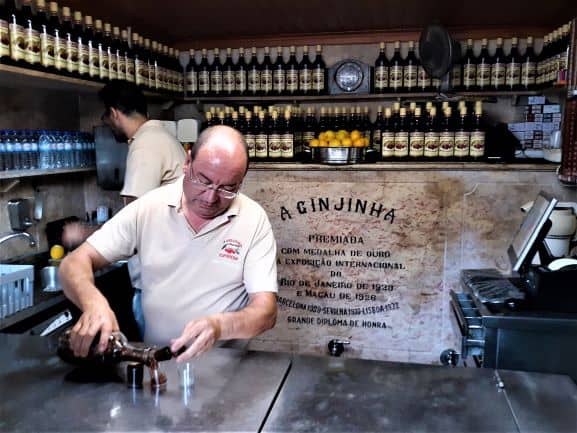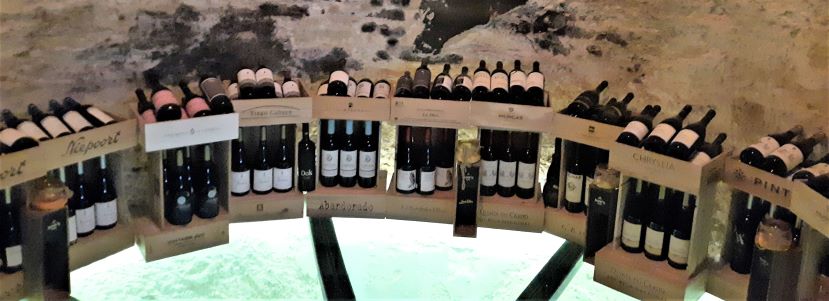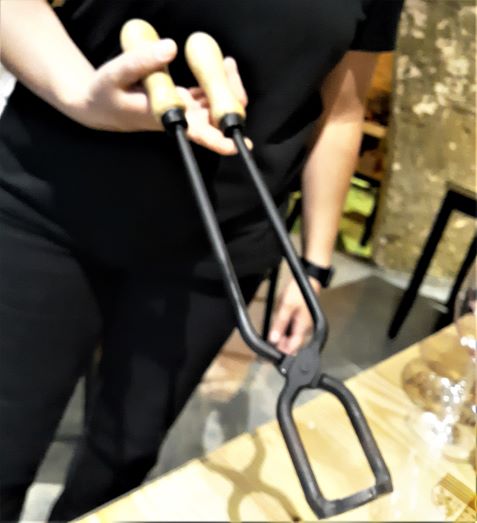Coffee, Wine, and sweet, local liqueurs. Lisbon is one of Europe’s best cities for liquid refreshment.
Ginjinha

Enjoying a Ginjinha is one of the highlights of a trip to Lisbon. Served in little plastic shot glasses and usually costing about 1.5€, getting a Ginjinha is cheap way to have some fun.
Ginjinha is made by adding cinnamon, sugar, and, sour cherries to brandy. The drink was invented by a friar at the Church of St. Anthony in Lisbon who added sour cherries to brandy. He shared the recipe with a Galecian man named Espinheira who perfected the recipe by adding sugar and cinnamon.
Espinheira opened the Ginjinha Espinheira bar in 1840 and today the place, now known as A Ginjinha, is still in business.
Don’t expect to come in and sit down for a drink at A Ginjinha. The bar is nothing more than a counter that opens to the square. Bartenders pour shots of the sweet drink into tiny plastic cups. Get yours with or without a cherry in the glass and stand outside with the locals and tourists enjoying the sweet elixir.
Another characteristic Ginjinha bar is just a couple minutes walk away. Ginjinha Sem Rival has been in business since 1890.
If you talk to Lisboetas who are middle-aged or older, they will likely tell you about how their parents and grandparents would give them a little shot of Ginjinha to cure everything from the common cold to a sore throat.
Wine
If you want to drink local wine in Lisbon, you’re in luck. There are several wine regions close by.
Many of the vineyards in the Lisboa wine region (until recently known as Estremadura) are small farms that sell their grapes to co-ops for Portuguese table wines. But there are also some regions that make fine wine as well.

When looking to buy a bottle, look for the DOC classification (Denominação de Origem Controlada) on the bottle. This indicates that the wines have been tested and tasted and the grapes have been grown in a certain geographic region that is particularly good for winemaking.
Another classification, Indicação de Proveniência Regulamentada (IPR) is just under DOC in prestige.
The next classification is Vinho Regional (sometimes listed as IG or IGP on the bottles). These wines are produced under less strict regulations and often contain lesser-known regional grape varietals.
The last classification is Vinhos de Mesa. These bottles are table wines.
Within Lisboa, there are several regions with the prestigious DOC designation.
Because Lisbon’s suburbs are expanding outwards, many vineyards have been plowed under to make room for expensive housing in the countryside. But, some areas, like Bucelas have expanded grape production. Bucelas is known for its white wines, especially those made with Arinto grapes and blended with Esgana Cão. These nice acidic whites often have notes of citrus and won’t bust your budget.

If you prefer red, look for bottles from the Arruda and Alenquer DOC in Lisboa.
The most interesting region is Colares, The vineyards of Colares DOC are planted in a sand. And, since phylloxera aphids cannot live on sand, these are rare European vines.
Almost all the vineyards in western Europe were devastated by phylloxera in the mid 1800’s. Vitners replanted with New World rootstock, which was immune to phylloxera. But, what phylloxera couldn’t kill, sprawl has. 98% of the vines under cultivation in Colares have been removed for suburban construction.
Lisbon Winery
One of my favorite places to do a wine tasting is at Lisbon Winery in Bairro Alto. The funky atmosphere has a cool cellar with a small transparent floor overlooking a pit filled with corks.
The owner of Lisbon Winery, Adriana, is super knowledgeable about Portuguese wines and is happy to answer all your questions. They also have a great selection of cheeses to pair with your vinho selection.
I noticed a bottle displayed on the shelf in which there was a perfect cut across the neck of the bottle. Our server explained that the tradition was to open a bottle of vintage Port by heating the neck and using a pair of tongs to open it rather than by removing the cork.
I asked her if they had a pair of tongs at the winery and she came back a few moments later holding the large tool. Super cool, but I think a corkscrew would be much more convenient.

The Old Pharmacy

One of my favorite places in Bairro Alto is The Old Pharmacy. The Old Pharmacy is housed in, of course, an old pharmacy. But, instead of pills and elixirs, the glass cabinets are filled with old wine bottles and guitars. And, instead of compounds and cotton balls, big glass jars are filled with old corks.
Tables and chairs are converted wine barrels and the wait staff wears white jackets, making them look like pharmacists of old, adding to the charming atmosphere. In addition to a great selection of Portuguese wines, The Old Pharmacy has a nice selection of Petiscoes (Portuguese snacks or small plates).
The Old Pharmacy contrasts nicely with some of the rowdier bars in Bairro Alto.
Little Wine Bar

Expect to do a lot of climbing in Lisbon. It’s called the City of Seven Hills, after all.
Karen and I were climbing flight after flight of stairs from the lower area near Avenida da Liberdade. At 192 stairs, yes I counted, a place caught my eye. Truthfully, Starbucks would’ve caught my eye at that point. But, this place looked good. Karen agreed, and we abandoned our upward march for a table at the Little Wine Bar.
The name is appropriate. The little place has about five tables and a tiny bar area. The space is so cramped that you’re elbow to elbow with the folks at the table next to you. But, that only adds to the charm of the place. The couple next to us were from Abruzzo, Italy. They spoke a little English and with our (very) rudimentary Italian, we had a lovely conversation.
The owner of the Little Wine Bar suggested a few vintages for us and they were right on the mark. The food is pretty darn good as well.
Coffee
Lisbon is famous for the Pastel de Nata (custard tart). There’s no better compliment to this treat than an espresso, or as it’s known in Lisbon, uma bica.
Coffee has been popular in Portugal for centuries ever since the imperial Portuguese brought coffee plants to colonies like Angola, Cape Verde, and, especially, Brazil. Today, Portuguese-speaking Brazil is far and away the largest exporter of coffee beans in the world.
You can get a an excellent uma bica at many Lisbon bakeries like Pastelaria Santo Antonio, but a highlight of a trip to Lisbon is a stop at Café A Brasileira.
In the early 1900’s coffee was not especially popular in Portugal. But, in 1905, Adriano Telles aimed to change that by importing and selling Brazilian coffee at his shop called A Brasileira. Customers who bought a bag of beans were treated to a free cup, uma bica. Shortly thereafter, a cafe was added which became a meeting place for the intellectuals, poets, and revolutionaries who were working to move Portugal from a monarchy to a modern government.
One of the most famous of these was Portuguese poet and writer Fernando Pessoa. He authored Mensagem (Message) along with hundreds of other works. A frequent customer of A Brasileira, he now permanently sits outside the cafe in the form of a bronze statue.
Inside, the art deco cafe is now mostly filled with tourists and students, but the striking atmosphere is still a great place for uma bica.
Amendoa
Portugal is a big almond producing country. The northeast region of Trás-os-Montes is where the majority of the country’s almonds are grown. Sweeter varieties of almonds are sold for snacking, but the region also grows a famous bitter almond. These are not popular for eating raw or roasted so many of the bitter almonds grown here are distilled into a liqueur called Amendoa.
Amendoa has a golden color and slightly sweet taste of vanilla and nuts. With 20% ABV, Amendoa isn’t meant to be chugged. Instead, a small glass is often offered as a digestiv. Sometimes you’ll see Amendoa used as a topping for ice cream.
If you’ve ever had Amaretto from Italy, you’ve tasted a similar drink. However, today, most commercial Amaretto is made from peach pits rather than the traditional bitter almonds. Besides, there’s nothing like sitting in a cafe in Lisbon while sipping an Amendoa and watching the trams and people go by.
About the Author

Brent Petersen is the Editor-in-Chief of Destination Eat Drink. He currently resides in Setubal, Portugal. Brent has written the novel “Truffle Hunt” (Eckhartz Press) and the short story collection “That Bird.” He’s also written dozens of foodie travel guides to cities around the world on Destination Eat Drink, including in-depth eating and drinking guides to Lisbon, Porto, Sintra, Monsaraz, and Evora in Portugal. Brent’s podcast, also called Destination Eat Drink, is available on all major podcasting platforms and is distributed by the Radio Misfits Podcast Network.
